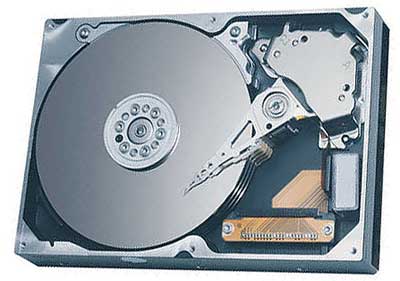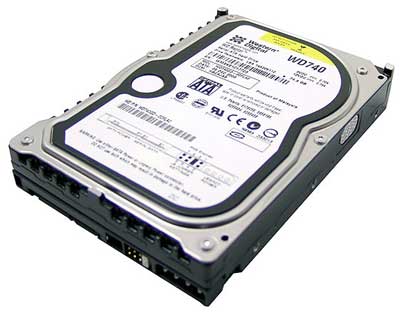Buyer's Guide - Mid-Range, October 2004
by Jarred Walton on October 21, 2004 11:00 AM EST- Posted in
- Guides
Hard Drive Recommendations
With our budget requirements, the one thing that we are definitely looking for in any hard drive is a SATA interface. The cables are much easier to work with and do not restrict air flow as much as the old IDE cables, and the price difference is negligible. Note also that many of the newer Intel motherboards only include one IDE port, which will usually be used for optical drives. As for what people will need, we feel that content creation work definitely requires a lot of hard drive space, as complex images and movies can rapidly fill up even the largest of hard drives. Software development is probably the least demanding in terms of space, so a smaller drive is usually more than sufficient. For frequent compiling of large projects, a faster hard drive subsystem can definitely improve performance, which is something to consider.The subject of RAID often comes up when discussing hard drives and we will continue to stick with our opinion that RAID 0 does not improve performance enough to justify the cost and the increased hassle for desktop systems. Anyone who doesn't think RAID 0 can be a hassle has never tried to upgrade motherboards while keeping the same hard drives. Data transfers are indeed faster, but very few applications (other than server use) are hard drive limited. You're free to use RAID 0 if you want to, but we simply do not feel that it is necessary.
RAID 1, on the other hand, is somewhat more reasonable. A good backup strategy is always important, but most of us get lazy and forget to do it very often. If you use your computer in a business setting, the loss of even a week's worth of data can be very painful, not to mention the down time as you reinstall your OS and applications. It still isn't necessary, but the extra $100 or so for a redundant hard drive should easily be recouped if you ever experience a drive failure. You ought to backup files in some other way as it is possible to have a catastrophic failure that takes out both hard drives, but RAID 1 is still better than nothing. Our recommendations and alternatives will not include RAID in any form, but you should now have enough information to determine if it's something that you want to check out.

Hard Drive Recommendation: Samsung 160GB SATA 7200RPM 8MB Model SP1614C
Price: $95 Shipped (OEM)
Most people don't need the fastest or largest hard drives, so our recommendation is to get a hard drive that offers decent performance and capacity at a good price. The Samsung SATA drives strike a nice balance and get our recommendation. Most of the 7200RPM SATA drives perform about the same, but the Samsung is quiet and costs less than other drives. At 59 cents/GB, this drive is about as cheap as you can get for storage without sacrificing performance. Seagate, Western Digital, Hitachi and Maxtor all offer similar performance, so if you prefer one of those and can find it at an acceptable price, they are also good choices.

Capacity Alternative: Maxtor 300GB SATA 7200RPM 16MB Model 6B300S0
Price: $209 Shipped (OEM)
With its 16MB of cache, the performance of the latest Maxtor drives is very close to that of the Western Digital Raptor, and it offers four times as much storage capacity. The cost is relatively high, but for those looking for large amounts of storage, it isn't that bad. 250 GB drives are about $60 less, but they only come with 8MB of cache. The Maxline-III series also includes support for SATA-II and Native Command Queuing, although like RAID 0, that tends to be more important in servers than in desktop PCs. If you are looking for more storage at a lower cost per megabyte, the 200GB drives offer the best value: 58 cents/GB. If 300GB of storage is more than you need, look at our other recommendations.

Performance Alternative: Western Digital Raptor 74GB SATA 10,000RPM 8MB Model WD740GD
Price: $173 Shipped (OEM)
The Western Digital Raptor has become synonymous with hard drive performance, and out of all of the potential uses for a Raptor, we feel that serious software developers stand to see the most benefit. Our reasoning is two-fold. First, software developers rarely have need of large amounts of storage, so the 74GB size isn't a problem. Second, compiling, debugging and testing of software tends to hit the hard drive a lot. Consider the following day in the life of a software developer (personal experience for some of our staff): show up at work, update your source code from the data repository (assuming you aren't in the middle or debugging some code before checking it in), compile the code, and test out the functionality. Modify some code, lather, rinse and repeat. Debugging may involve dozens of recompiles in a day, and if multiple developers are working on fixing a problem, code updates and recompiles can occur even more often. (Crunch time... shudder.) A moderately complex project with several hundred thousand lines of code might take a few minutes to compile with a slower hard drive, while the Raptor is noticeably faster. Is it necessary? No, but if you're going to splurge on components for a software development workstation, the hard drive is one area that could use some TLC.










54 Comments
View All Comments
Avalon - Friday, October 22, 2004 - link
For the s754 system, to clarify. Sorry. Wish these posts could be edited :)Avalon - Friday, October 22, 2004 - link
If you wanted to cut an additional ~$50, switch out that MSI K8N Neo Platinum and throw in an Epox 8KDA3J. It's only $73 on newegg, shipped, which is within a dollar or two of the Chaintech VNF-250, but has loads more features. After all, you guys gave the 8KDA3+ an editor's choice award, so why not recommend the "value" board in a mid range rig? It's an option to ponder over.dragonballgtz - Thursday, October 21, 2004 - link
A $200 CPU would go better with a 9800Pro IMHO for gamers.JarredWalton - Thursday, October 21, 2004 - link
ksherman, that's basically what I went with, but outside of gaming there is no real need for a fast graphics card. $200 for a graphics card that many people do not want/need is difficult to justify. Rather than create more confusion with talk of gaming alternatives, we are going to look at putting together a Gaming Guide in the near future.The Mid-Range PC is such a broad segment that it is virtually impossible to cover all options without writing a 20,000 word article. This one is already long enough, and that was after I removed the gaming options. Here's the basics, though:
If you want a moderate gaming card for AGP, about the only reasonable choice right now is a 9800 Pro. The 6800/6800GT are too expensive for most people, I think. PCI Express has the 6600GT which tends to be faster than the 9800 Pro by about 10 to 20%. As games are GPU limited in most cases, AMD fans will probably either want to wait for PCI Express motherboards and get a 6600GT, or else bite the bullet and spend $360+ on a 6800GT. Ouch. :)
Beenthere - Thursday, October 21, 2004 - link
Nice guide. Lotta work !!!I think the biggest issue for most folks looking to build a new PC or even to upgrade within a budget, is prioritizing. As you can see from the comments above, gamers always want a top-of-the-line Video card even when this takes a big bite outta the budget. To do that you gotta cut cost some place else and that may compromise the total system performance.
Seems to me that an easy means to quantify and qualify the real options for an individual system would be by listing the hardware categories as you've done on a spreadsheet then plug in the hardware and prices accordingly. I think some folks would be surprised to see how their total system price climbs way beyond their original budget when you add $50. here and there to get the "best" of a particular component or to step up to the next level of component.
As you pointed out, sometimes like with memory, buying the lowest latency modules may cost more than moving up 200 MHz in CPU speed, so the CPU may be a better choice. Your guide and recommendations give PC builders a great head start on getting the most bang-for-their-buck.
Thanks for the effort!
ksherman - Thursday, October 21, 2004 - link
also, I think that a good description for a mid range system should be a system with a good amount of power (hence the processor choice) with out the price premium. I like mid-ranges because they offer the power i need with the versitility to do anything I will need to do for a while down the road.ksherman - Thursday, October 21, 2004 - link
It is kinda weird that you recommend such a low-end card for a mid-range system... to me (as everyone else has stated) the 6600 and 9800's should be in the midrange systems. 9600 and similar should be put into low-end systems... in regards to the x300, you state that it is good for those not into gaming so much as other "basic computing tasks", I think that something like that belongs in the low-end systems category.JarredWalton - Thursday, October 21, 2004 - link
I have made a few minor corrections, and I also added a $1000 AMD 754 system to the summary page, for those that might feel $1250 is too much. :)#3: Corrected, thanks. MB, GB... sometimes my fingers have a mind of their own.
#7: RAID 1 hardware controllers should not incur any noticeable performance penalty, as they simply tell both hard drives to write the same data. Better RAID 1 controllers will actually have improved read performance, as they can pull data from two sources. I have not done any extensive testing of this, however, and would guess that most integrated RAID controllers lack that feature. If anyone knows for sure, speak up.
#12: I didn't put much of an emphasis on gaming, as I hope to cover that more in an upcoming Gaming Guide. We'll see if that gets a green light - it's been a while since we covered that topic in depth, I think, although the Doom 3 craze touched on it.
#15: Stay tuned. That's all I will say for now. The Pioneer is still a good choice, though.
#16: Is that typo corrected now? If not, which page are you seeing that on, since I checked both the Display and Summary pages for the error.
Thanks!
Desslok - Thursday, October 21, 2004 - link
That monitor costs as much as the whole system would?NEC/Mitsubishi FE991SB-BK 19" 1274?????
deathwalker - Thursday, October 21, 2004 - link
Great article...I am a little surprised at the Optical Drive choice of the NEC 3500A @ $73, reason being is that you just reviewed the Pioneer 108 and called it the best drive reviewed to date and its only $78.